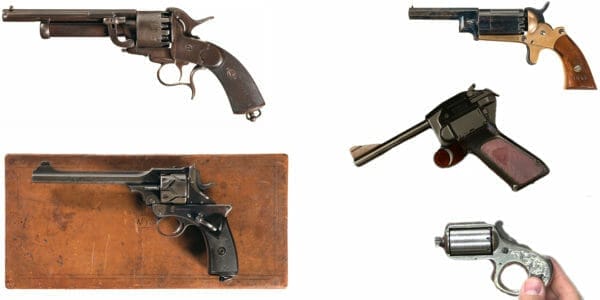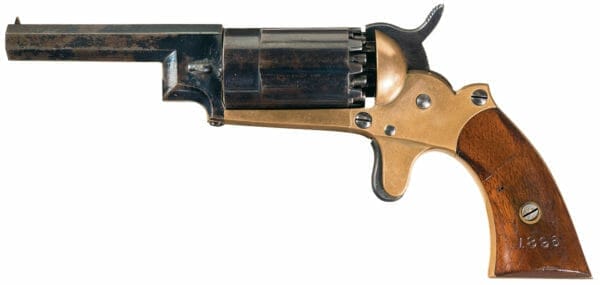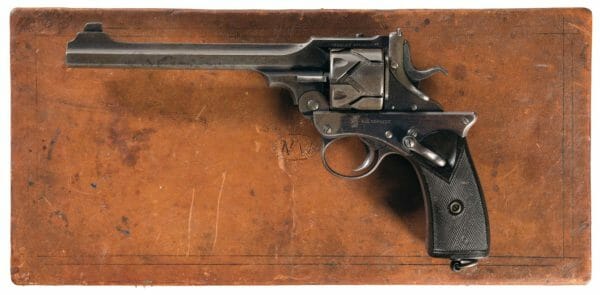
U.S.A. – -(Ammoland.com)- Revolvers have been around for the past couple hundred years, give or take a few decades and depending on how, exactly, you define “revolver.” Today’s definition of what a revolver is has been established for more than a century, but that doesn’t mean there haven’t been experiments with the design and basic idea of a revolver since.
Here’s a look at 5 interesting revolver designs from the past.
LeMat “Grapeshot” Revolver

The LeMat is probably the most well-known type of unconventional revolver. Invented by Jean Alexandre LeMat, this handgun was patented in 1856 and saw some use during the Civil War by soldiers in the Confederacy. Confederate General P.G.T. Beauregard helped fund the gun, and both he and General J.E.B. Stuart were known to have carried them.
The gun got the nickname “grapeshot revolver” because the normal revolving cylinder, which held nine rounds of pistol ammo, did more than just revolve for each shot. In the center was a single, larger chamber, usually measuring the equivalent of 20 gauge in diameter, that had its own shorter barrel mounted under the pistol barrel.
Essentially, this allowed the LeMat to operate as a standard revolver with a “last ditch effort” in the form of a short-short-short-barreled shotgun. The shotgun was discharged by flipping down a piece of the hammer that changed the angle of its strike, allowing it to ignite the shotgun charge.
The guns were made in the US, England, France, and Belgium. Despite so many locations, fewer than 3,000 were made.
The design was certainly innovative, but it wasn’t very practical. The LeMat was heavy and awkward, and it required the shooter to carry multiple kinds of ammo in order to reload properly and use the gun to its full potential. Not to mention that firing a handgun shotgun isn’t the most pleasant thing in the world!
Walch Pocket Revolver

One way to increase the capacity of a revolver is to load it with superposed charges, that is, one stacked in front of the other so that you have two rounds in each chamber. That’s the concept used by John Walch in 1859.
In order to fire this gun properly, you need two hammers and, on some models, two triggers. Either way, the hammers are designed to reach percussion caps mounted in slightly different locations on the cylinder.
To fire the front shot (which must always be done first to avoid blowing up the gun), you cock the corresponding hammer which, upon striking the percussion cap, channels the ignition on an angle, allowing it to bypass the powder and ball at the back of the chamber.
Once the front charge has been shot, the rear one can be safely discharged. This is done like any other conventional percussion revolver, as the ignition channel is in direct alignment with the back of the cylinder.
As mentioned previously, a careless user could accidentally cock the wrong hammer and fire the second shot first, thereby blowing up the gun and causing serious injury to the user. As a result, it’s easy to see why the guns didn’t catch on.
Knuckledusters

The design known as the knuckleduster is named as such because it could be rotated on your finger and the butt of the piece could be used as a singular brass knuckle. The gun had no barrel and fired directly from the cylinder, adding to its ability to be concealed, but relegating it to extremely close-quarters use. They were available in .22, .32, and .41 calibers.
The small and concealable design made it popular with women and travelers so that they could have something handy when out on the dangerous roads. It was also a popular design with gamblers who might need some concealed backup when the other players found the fifth ace they were hiding in their sleeve.
Despite their small size, the all-metal guns were well made and even featured scroll engraving on both sides of the frame, the topstrap, and even the front of the cylinder, making the gun both (somewhat) practical and attractive.
The most well-known versions of these guns were made by James Reid, and he called them the “My Friend” knuckleduster. All told, he made approximately 13,940 of them.
Webley-Fosbery Automatic Revolver

The zig-zag grooves on the revolver’s cylinder are the model’s most iconic visual and functional distinction. Patented by William John Whiting in 1901, the grooves played an important role in the gun’s operation.
When the top half of the revolver recoiled to the rear, the cylinder grooves were engaged by a stud on the frame. This engagement provided 30 degrees of rotation. As the recoil spring pushed the revolver forward, the cylinder rotated another 30 degrees and placed a new cartridge in line with the firing pin.
It was this motion that led to the gun being called an “automatic revolver.” While the design had its advantages, it was not without drawbacks. The Webley-Fosbery was expensive to manufacture and, in turn, expensive to buy. When the gun was made available to the public in 1901, you could buy a Mauser C96 Broomhandle pistol for 10 shillings less than a Webley-Fosbery.
When the gun made its debut at the Bisley Shooting Ground, it was met with great fanfare and copious amounts of positive press.In 1902, famed target shooter Walter Winans fired 12 shots (which included a reload) in a two-inch group at 20 yards in only 20 seconds. Rapid reloading was accomplished through the use of a Prideaux speedloader. The attendees at the St. Louis World’s Fair in 1904 also lauded the design. Unfortunately, commercial approval only goes so far; a military contract was necessary in order for the design to survive. Ultimately, no contract materialized and production of the Webley-Fosbery ceased.
During the gun’s entire production, only 4,200 were produced. Of that total number, almost all were chambered for the .455 Webley. Approximately 200 left the factory chambered for .38 ACP.
Dardick Model 1500

In August 1958, David Dardick received a patent for a magazine-fed revolver. His design featured a cylinder with openings on each exterior edge, creating U-shaped chambers instead of traditional O-shaped chambers. This allowed rounds to be automatically fed into the chamber from a magazine loaded with a stripper clip, instead of being loaded manually like in a traditional revolver. Additionally, extraction was also done automatically.
Dardick soon realized that his U-shaped ammunition would require it to be fed in a very specific fashion in order for his revolver to function properly. By the end of 1958, he was issued a second patent that shows his ammunition now being three-sided like a triangle. The uniform size of the round on each side enabled it to feed into the cylinder more easily, thereby increasing the gun’s reliability.
The new triangular ammunition needed a name, so Dardick called them “trounds,” a combination of the words “triangle” and “round.” The bullet, powder, and primer were all loaded into the triangular-shaped plastic case that created the outer wall of the revolver’s cylinder.
The Model 1500 had interchangeable barrels and could fire .38, .30, and .22 caliber trounds. It was also available with a carbine conversion kit to turn the revolver into a rifle.
Shortly after introduction to the public, Mechanix Illustrated magazine featured an article on the new gun. Its author called it “as versatile as a six-armed monkey.” While the analogy may seem to be an unusual way to praise Dardick’s creation, it proved to be accurate in a way the author never intended: just like there’s no such thing as a six-armed monkey, there’s also no such thing as a commercially-successful, magazine-fed revolver that fires rounds from a plastic triangle.
The public never embraced his concept and Dardick’s trounds remain little more than a footnote in the advancement of ammunition.
Looking Back, Looking Forward
As we’ve seen with these five revolvers, some of their inventors looked to designs from the past to find their way to the future. You never know what, exactly, will work and what will not until it is put into practice.
With the benefit of hindsight, we can see that most of the revolvers here were doomed to fail, but that didn’t deter their inventors from trying. In that same inventive spirit, who knows what kind of new revolver we might see at the next SHOT Show!
About Logan Metesh
Logan Metesh is a historian with a focus on firearms history and development. He runs High Caliber History LLC and has more than a decade of experience working for the Smithsonian Institution, the National Park Service, and the NRA Museums. His ability to present history and research in an engaging manner has made him a sought after consultant, writer, and museum professional. The ease with which he can recall obscure historical facts and figures makes him very good at Jeopardy!, but exceptionally bad at geometry.

